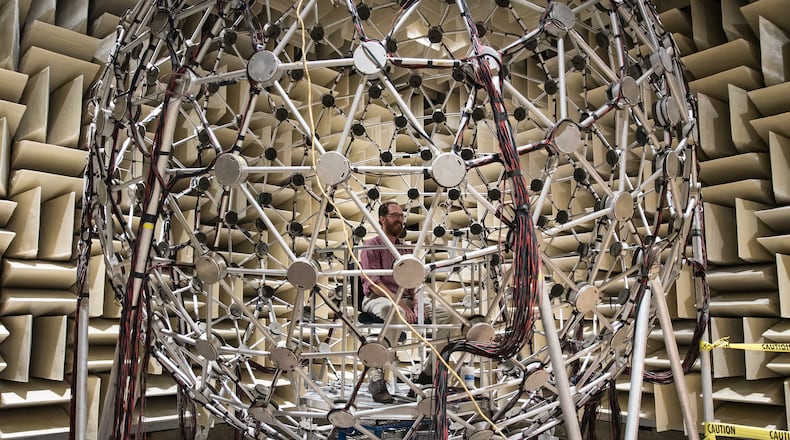While Ohio lawmakers passed a resolution recommending that the elder Cavanaugh be recognized — and the Air Force has expressed appreciation for Cavanaugh’s work — Air Force representatives conveyed to Sen. Sherrod Brown’s office that the service will not rename the facility for Cavanaugh.
A Dec. 6 letter from Brown’s office to John Cavanaugh cites two principal reasons for the decision — Col. Cavanaugh’s “overall limited involvement in the Air Force” and the fact that Air Force policy does not allow memorializing or naming service property for contractors.
“As the proposal to recognize him is for his work as a contractor, and not an Army colonel or private sector individual, the relationship is based on a ‘commercial or profit-making relationship,’ and thus memorialization would be prohibited,” Brown’s office quoted an Air Force representative as saying in the Dec. 6 letter.
The same standard applies to historical markers and placards, according to Brown’s letter.
“Unfortunately, due to DAF (Department of the Air Force) policy, and ethics concerns, the Air Force is unable to rename any facility at AFRL after Col. Cavanaugh at this time,” Brown’s office told the younger Cavanaugh.
Cavanaugh is frustrated. “He was a great man, a great father, he uplifted everyone in sight,” he said.
In response to questions from this newspaper, Brig. Gen. Robert K. Bogart, commander of the 711th Human Performance Wing, emphasized that the wing and the Air Force are thankful for Cavanaugh’s service.
But he added that Air Force memorialization policies are meant to “provide lasting honor and pay tribute to deceased as well as living Air Force military and civilian personnel with records of outstanding and honorable service.
“While we are certainly thankful for his contributions in designing the anechoic chamber, Col. Cavanaugh worked as a contract employee while working on the anechoic chamber,” Bogart said. “Due to his overall limited involvement with the Air Force, there are no current plans to rename the chamber after him.”
An anechoic chamber is a room designed to dampen echoes of sound. Researchers from the Battlespace Acoustics Branch, part of the 711th Human Performance Wing at Wright-Patterson, have used anechoic chambers to research how to protect hearing in noisy environments, among other research objectives.
An Ohio House measure urging recognition of Col. Cavanaugh was directed to the Ohio Senate, which passed it in late 2022.
“That’s too bad,” State Rep. Brian Lampton, R-Beavercreek, one of the principal co-sponsors of the state legislation, said Wednesday when he learned of the Air Force’s decision. “It’s certainly disappointing. I guess I want to leave it at that. I’m disappointed.”
The state bill recommended that the Air Force Research Lab (AFRL) at Wright Patterson recognize Cavanaugh for his contribution to the design and architecture of the AFRL Bio Acoustics Laboratory, building 441 on Wright Patt’s Area B.
Lampton added that he understood the Air Force’s position, however. “I totally understand. It’s a military installation. It’s U.S. government property. You don’t want to let that start. Because it’s going to open up floodgates for all kinds of naming of things.”
Asked to expand on the situation, a spokesman for Brown referred back to the senator’s letter to John Cavanaugh. In a statement, however, he later said that Brown advocated for Col. Cavanaugh “to receive this well-deserved recognition and will continue to look for opportunities to honor his legacy.”
Ohio legislators cited a 2018 Wired magazine article describing the Wright-Patterson chamber.
“The chamber helps with a wide range of research efforts focused on human perceptions of sound,” Wired said, citing Brian Simpon, a senior engineering research psychologist with AFRL.
“We have psychologists, engineers, physicists, and audiologists working on these problems, and this chamber gives us tremendous capability,” Simpson told Wired. “There’s nothing quite like it in the world.”
The Dayton Daily News requested an interview about the situation with an AFRL representative.
In an interview, the younger Cavanaugh, who owns a Columbus business consulting firm, said base personnel explained “the contours and difficulties at the time of naming things” after people in a 2021 meeting.
“I was OK with that,” Cavanaugh said in an interview. But he said he still would like the base to recognize his father’s work somehow, perhaps with a “historical marker.”
“I just wanted his work recognized,” he said.
About the Author

